OLIVES
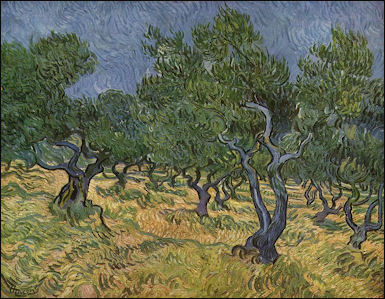
Olive trees by van Gogh Olives are fruit that comes from a gnarled tree and are a staple of the Mediterranean diet. People eat them for meals and snacks, and use olive oil for cooking and even eat on bread. They come in host of colors and textures: salty, wrinkled and black; oily and green; and even massive and purple. Italy alone is home to 60 different types of olive tree. [Source: Dora Jane Hamblin, Smithsonian; Erla Zwingle, National Geographic, September 1999]
Through the ages, olives and olive oil have been used as food, fuel, light source, lubricant, soap, mediation, weapon and sacred oil. Among the historical figures who ate olives were Plato, Aristotle, Caesar, Christ, the Apostles, Dante, Leonardo da Vinci, Michelangelo, Columbus and Galileo.
A food critic who divided Europe into regions of butter, lard and olive oil and discovered the most passionate people lived in regions dominated by olive oil. It also the lifeblood for regions have difficulty producing other crops. "The olive tree looks like death, but to countries where it grows, it sometimes literally means life. The olive is as much a savior of man in semi-arid areas of poor soil as the date of the oases in the desert."
The olive is a drupe, or stone fruit, like a plum or cherry. Olives start out green and very bitter and turn black when they mature. A bitter olive eaten raw off a tree is like eating "a unplucked chicken or a an uncooked potato." Different varieties of olives are usually picked at different points in the development of the fruit. Green olives generally have more Vitamin E and less oil than black olives, which have a stronger flavor and more oil. Most green olives are eaten whole rather than made into oil. Only 10 percent the olive crop is eaten as olives. Most is made into oil.
Websites and Resources: Olive Oil Source oliveoilsource.com ; Olive Oil articles in Global Gourmet globalgourmet.com/ ; Wikipedia article on Olive Oil Wikipedia ; An Ode to Olives: emeraldworld.net ; Making Olive Oil oliveoilsource ; Type of Olives foodsubs.com/Olivpick ;
Book: “Olives, the Life and Love of a Noble Fruit” by Mort Rosenblum (North Point/ Farrar Straus Giroux).
World’s Top Olive Producing Countries
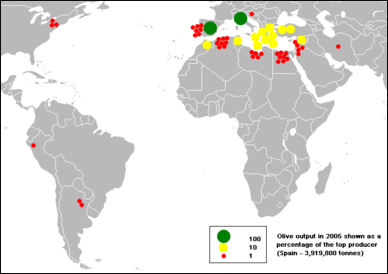
Top olive-producing countries World’s Top Producers of Olives (2020): 1) Spain: 8137810 tonnes; 2) Italy: 2207150 tonnes; 3) Tunisia: 2000000 tonnes; 4) Morocco: 1409266 tonnes; 5) Turkey: 1316626 tonnes; 6) Algeria: 1079508 tonnes; 7) Egypt: 932927 tonnes; 8) Syria: 781204 tonnes; 9) Portugal: 722580 tonnes; 10) Argentina: 366503 tonnes; 11) Saudi Arabia: 364546 tonnes; 12) Peru: 174238 tonnes; 13) Jordan: 173083 tonnes; 14) Libya: 172519 tonnes; 15) Lebanon: 136384 tonnes; 16) Albania: 131971 tonnes; 17) Chile: 130444 tonnes; 18) Iran: 108277 tonnes; 19) Palestine: 89263 tonnes; 20) Israel: 83000 tonnes ; [Source: FAOSTAT, Food and Agriculture Organization (U.N.), fao.org. A tonne (or metric ton) is a metric unit of mass equivalent to 1,000 kilograms (kgs) or 2,204.6 pounds (lbs). A ton is an imperial unit of mass equivalent to 1,016.047 kg or 2,240 lbs.]
World’s Top Producers (in terms of value) of Olives (2019): 1) Spain: Int.$6364383,000 ; 2) Italy: Int.$2340984,000 ; 3) Morocco: Int.$2040243,000 ; 4) Turkey: Int.$1627084,000 ; 5) Greece: Int.$1310341,000 ; 6) Egypt: Int.$1152392,000 ; 7) Portugal: Int.$1063782,000 ; 8) Tunisia: Int.$935575,000 ; 9) Algeria: Int.$926908,000 ; 10) Syria: Int.$900835,000 ; 11) Argentina: Int.$347675,000 ; 12) Jordan: Int.$229386,000 ; 13) Peru: Int.$203771,000 ; 14) United States: Int.$162122,000 ; 15) Libya: Int.$149558,000 ; 16) Lebanon: Int.$143503,000 ; 17) Chile: Int.$134510,000 ; 18) Israel: Int.$115230,000 ; 19) Iran: Int.$108140,000 ; [An international dollar (Int.$) buys a comparable amount of goods in the cited country that a U.S. dollar would buy in the United States.]
Top olive-producing countries in 2008: (Production, $1000; Production, metric tons, FAO): 1) Spain, 2739128 , 5475300; 2) Italy, 1737737 , 3473600; 3) Greece, 1157152 , 2313055; 4) Turkey, 732519 , 1464248; 5) Tunisia, 591819 , 1183000; 6) Syrian Arab Republic, 413739 , 827033; 7) Morocco, 382896 , 765380; 8) Egypt, 240165 , 480071; 9) Portugal, 172993 , 345800; 10) Algeria, 127102 , 254067; 11) Libyan Arab Jamahiriya, 90048 , 180000; 12) Argentina, 75040 , 150000; 13) Jordan, 47059 , 94068; 14) Occupied Palestinian Territory , 42908 , 85770; 15) Lebanon, 38120 , 76200; 16) United States of America, 30316 , 60600; 17) Peru, 28865 , 57700; 18) Australia, 28576 , 57123; 19) Albania, 28115 , 56200; 20) Israel, 24388 , 48750;
History of Olives
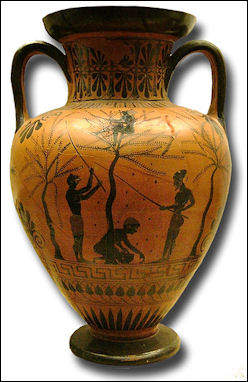
Greek jug showing olive harvesting Olives were one of the first processed foods. At a Stone Age site in Spain 8000-year-old olive seeds were found and archeologist speculate that the olives had to have been processed somehow, otherwise they would have been too bitter to eat. According to Archaeology magazine: Chemical analysis of organic residues in ceramic vases found at the Early Bronze Age settlement of Castelluccio in Sicily has revealed that at least three of the jars once held olive oil. The pottery dates to the end of the 3rd millennium B.C., which proves that some ancient Italians were producing olive oil almost 700 years earlier than was previously thought. [Source: Archaeology magazine, September-October 2018]
The ancient Egyptians, Phoenicians, Greeks, and Romans all consumed olives and olive oil. Olives were first cultivated in Palestine around 4000 B.C. and spread to Syria and Turkey and reached the ancient Egypt around 1500 B.C. (the Egyptian were using olive purchased from Palestine long before that). The Phoenicians took olives to Carthage and Greece and the Greeks took them to Italy, southern Spain, and Sicily. The Romans brought them to southern France.
The Greeks and Romans used olive oil as food, soap, lotion, fuel for lamps and fragrances, as a base for perfumes and treatment for heart ailments, hair loss, stomach aches and excessive perspiration. The Greeks rubbed cult statues with olive oil. Romans burned it in the alter of their gods. Greek athletes anointed their bodies with olive oil scented with flowers and roots when they worked out and competed.
Greeks believed that olive oil was a gift to humanity from Athena and Olympic champions were rewarded with a crown of olives. Zeus decreed that the city that would become Athens would given to the god who produced the most useful thing for mankind. Poseidon gave them a horse. Athena stamped on the ground with a spear: an olive tree sprung up. The people liked olives so much that Zeus gave the city that became named after her. The olive branch became a symbol of peace.
In the Roman Empire olive oil was a major cash crop. Consumption by individuals rose to as much as 50 liters a year and some families grew quite rich trading it. In many ways olive oil was valued as much in ancient times as petroleum is today, with governments going to great lengths to make sure there was a steady supply. Some emperors gave it out free to the masses as part of their bread and circuses policy.
Jesus was anointed with olive oil (Christ means the "anointed one") and olive trees that date back to Christian times can still be found on Israel. Olives were also important to Muslims. Islam's oldest university, in Tunisia is named “al-Zitouna” “the Olive Tree. Attica fell to Sparta after the Spartans uprooted their rival's olive trees.
The painter Renoir and the English actor Dirk Bogarde both mounted campaigns to save abandoned olive trees. Renoir loved to paint olive groves and once said "the sky that plays across them is enough to drive you mad."
See Separate Articles: EARLIEST NON-GRAIN CROPS: NUTS, BEANS, OLIVES, FRUIT AND POTATOES factsanddetails.com factsanddetails.com KINDS OF FOOD IN ANCIENT ROME: MEAT, BREAD, SEAFOOD, FRUITS, OLIVES, CEREALS, SAUCES AND SPICES factsanddetails.com
Origins of the Olive Tree
The earliest known evidence of domestication of a fruit tree was uncovered at the Chalcolithic site of Tel Tsaf in the Jordan Valley in Israel. According to Archaeology magazine: During excavations, archaeologists unearthed the 7,000-year-old charred remains of wood, which they determined belonged to olive trees. Although prevalent throughout the Mediterranean world, olives are not endemic to the Jordan Valley. Experts believe that olive trees were imported to the site and cultivated there, allowing its inhabitants to become wealthy by trading in the trees’ valuable products. [Source: Archaeology magazine, September 2022]

olives on a mosaic Olives were first domesticated in the Eastern Mediterranean between 8,000 and 6,000 years ago, according to research published in the February 5, 2013 issue of the journal Proceedings of the Royal Society B. The findings are based on the genetic analysis of nearly 1,900 samples from around the Mediterranean Sea. The study reveals that domesticated olives, which are larger and juicier than wild varieties, were probably first cultivated from wild olive trees at the frontier between Turkey and Syria. "We can say there were probably several steps, and it probably starts in the Levant," or the area that today includes Israel, Palestine, Jordan, Lebanon and Syria, study co-author Gillaume Besnard, an archaeobotanist at the National Center for Scientific Research in France told Live Science. "People selected new cultivars everywhere, but that was a secondary diversification later." [Source: Tia Ghose, Live Science, February 5, 2013 |**|]
Tia Ghose of Live Science wrote: “From biblical times, the olive tree has served as a symbol of sacredness, peace and unity. Archaeologists have unearthed olive pits at sites dating to about 8,000 years old. And dating as far back as 6,000 years ago, archaeologists find evidence of olive oil production in Carmel, Israel, Besnard said. Yet exactly where the olive was first cultivated has been hotly debated. |**|
“To unravel the history of the olive tree, the team took 1,263 wild and 534 cultivated olive tree samples from throughout the Mediterranean and analyzed genetic material from the trees' chloroplasts, the green plant structures where photosynthesis takes place. Because chloroplast DNA is passed from one tree to the descendant trees that spring up around it, the DNA can reveal local changes in plant lineages, he said. |**|
“The researchers then reconstructed a genetic tree to show how the plant dispersed. The team found that the thin, small and bitter wild fruit first gave way to oil-rich, larger olives on the border between Turkey and Syria. After that first cultivation, modern-day domesticated olives came mostly from three hotspots: the Near East (including Cyprus), the Aegean Sea and the Strait of Gibraltar. They were then gradually spread throughout the Mediterranean with the rise of civilization. |**|
“But to get a true sense of how the olive tree emerged, the researchers shouldn't just look at chloroplast DNA, said André Bervillé, a geneticist at the French National Institute for Agricultural Research, who was not involved in the study. Nuclear DNA, which is carried in the pollen, should also be analyzed, Bervillé told LiveScience. "Pollen from the olive tree is wind-transported, so it can migrate long distances" he said. Combining both types of DNA would allow researchers to understand both how local olive tree cultivation occurred and how more long-distance changes occurred, he said.” |**|
8000-Year-Old Olive Oil Found in Israel

ancient olive press
In 2014, archaeologists working in the Lower Galilee area of Israel said they found traces of 8000-year-old olive oil on clay shards, the oldest evidence of the use of olive oil in the Middle East, according to an article published in the Israel Journal of Plant Sciences. The Times of Israel reported: “Tests of potsherds, some dating back to 5,800 B.C., found in 2011-2013 during a salvage excavation ahead of the widening of Road 79, showed traces of olive oil remarkably similar to modern versions, researchers said. [Source: Times of Israel, December 17, 2014 /+]
“Ianir Milevski and Nimrod Getzov of the Israel Antiquities Authority methodically sampled pottery vessels found in the excavation at Ein Zippori in the Lower Galilee in order to ascertain what was stored in them and how they were used by the site’s ancient inhabitants. Although it is impossible to say for sure, this might be an olive species that was domesticated and joined grain and legumes – the other kinds of field crops that we know were grown then. Those crops are known from at least 2,000 years prior to the settlement at Ein Zippori. With the adoption of olive oil the basic Mediterranean diet was complete. From ancient times to the present, the Mediterranean economy has been based on high quality olive oil, grain and must, the three crops frequently mentioned in the Bible,” they said in a statement. /+\
“Their tests, conducted with Dvory Namdar of the Hebrew University of Jerusalem Institute of Earth Sciences, revealed that the pottery dating to the Early Chalcolithic period contained olive oil. A comparison of the results of the extraction from the archaeological sherds with those of modern, one-year-old oil, showed a strong resemblance between the two, indicating a particularly high level of preservation of the ancient material, which had survived close to its original composition for almost 8,000 years. /+\
“Of the 20 pottery vessels sampled, two were found to be particularly ancient, dating to approximately 5,800 B.C.. The researchers said the findings went hand in hand with recent finds at Kfar Samir, a 7,700-year-old site now underwater off the coast of Haifa, where the oldest evidence of olive oil production was discovered. “Now at Zippori, evidence has been found for the first time of the use of olive oil. Together with the Kfar Samir discovery, this is the earliest evidence of olive oil production in the country, and possibly the entire Levant (the Mediterranean basin),” the researchers said in a statement. /+\
“Milevski said the finddid not supply a definite clue as to whether the oil was used for consumption, lighting, or both. “We found two large vessels and another small one; all were probably only used to store the oil. What it was used for we can only guess.” Small clay candles, flat bowls filled with oil in which a wick was placed and lit, “date from later periods,” he added. Milevski said that on the same site the archaeologists found stone palettes with engravings of schematic female figures with animals around them. “In the same site we also found bones from the limbs of large animals engraved with images of eyes, trees and triangles symbolizing the female sex,” he said.” /+\
Olives from Different Countries

There are approximately 700 olive varieties, or cultivars. They taste different from one another and make oils different, if made properly, the same way different grapes varieties produce different-tasting wines.
Greek Olives are both black and green. They include the: Kalamata (popular black, large, purplish black,, mild vinegary taste), pitted Kalamata, Royal (medium-size, purplish brown to black, meaty, strong, tarty, vinegary flavor), Hios (medium size, brown, soft, cured in olive oil, very distinctive flavor), Giant Greek Green (very large, meaty, slightly bitter or sweet), Greek Green Naphlion, Marinated Green.
Italian olives are usually green. Among them are the: Cerignola Cerignola (very large, bright green, firm with a mild flavor) Cerignola (ripe Cerignola, soft and sweet), Sicilian Green (small, to large, juicy and salty with a vinegary flavor), Sicilian Pitted, Dry Roast (medium-size, black, wrinkled, slightly bitter taste), Gaeta (medium-size, strong fruity flavor, salt cured Gaetas are wrinkled with a mild bitter flavor), Bella Green.
French olives are usually green. They include the: Fontvielle en Provence (medium-size with mild tats, cured with rosemary), French Niçoise (small, purple, marinated in herbal brine, sharp and sour, with a large difficult-to-extract pit), Nypns (small, greenish, oil-cured, pleasant bitter flavor and seasoned with herbs, good for cooking), French Provençal Green, Picholine (small, medium-Greek, fruity, nutty and perfumey)
Spanish olives such as Arbequino (very small, light brown, nutty flavor) are usually green. Turkish olives like Turkish Black (medium-size, black, slightly wrinkled, nutty and salty), Turkish Oil Cured (medium-size, black, wrinkled, salty then mild and lingering) are usually black.
Other olives: Moroccan Oil Cured (medium-size, black, wrinkled, baked, then oil cured, bitter, smokey and salty flavor) Alfonso Chile/Peru (brine-soaked, red-wine cured, "fruity flavor and zesty aftertaste"), Lebanese Black (small, brown to black, slightly bitter aftertaste), Lebanese Green (small, crack flesh strong, salty flavor
Olive Oil
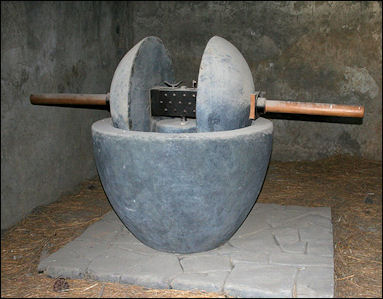
Olive press in Pompeii
Olive oil is a fruit juice (the only edible oil made from a fruit). It is prized for its rich flavor, purity and lack of greasiness. The oil content of an olive varies from 8 percent to more than 20 percent of the olive's weight, including the pit. Oil-rich varieties are generally used for making oil while less-rich strains are used for eating.
Most olives are made into olive oil. Oil-grade olives are usually 20 to 40 percent oil, not including the pit. The best grades of olive oil — virgin, sublime or 1st expressed oil — come from the pulp of olives picked in the brief time after they are ripened but before they turn black.
Olive oil is used to make salad dressings or to dip bread and can even be consumed by itself. Olive oil changes little at high temperatures, which makes ideal for cooking. It also an excellent preservative, used for keeping fish, cheese and even wine for years. Olive oil soaps don't produce much lather but they leave the skin feeling luxuriously smooth. Olive oil is also used in cosmetics; as a lubricant; to comb wool; and to polish diamonds.
Olive varies quite a bit from country to country. Italians, Spanish and French prefer light extra-virgin olive oil with an acidity level of less than one percent while Tunisians and Palestinians like strong oil with an acidity level between 2.5 and 4 percent. The oil from Tuscany is clear and green while that oil from Croatia has a rich golden color.
Olives, Olive Oil and Health
Consumption of olive oil is rising partly because of its touted health benefits. Olive oil is rich in polyphenols, chemicals that give the oil some zing and are credited with having a positive effect on the heart and circulatory system. It also is high in unsaturated fats, which are regarded as healthy and are linked to reductions in heart disease.
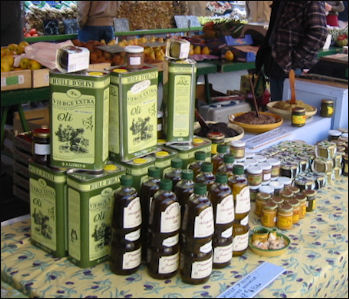
Olives are generally at least 75 percent fat. However about 80 percent of olive oil is made up of mono-unsaturated fatty acids, which resist oxidation and raises HDL (good) cholesterol and lowers LDL (bad) cholesterol levels in the blood. Olives also have high levels of Vitamin E, which helps the body absorb calcium (producing stronger bones) and is rich in alpha-linolenic acid, an omega-3 fatty acid that is found only in plants and is an essential nutrient in the human diet.
Olive oil is the most digestible of the edible oils and the lowest in cholesterol. It is credited with reducing levels of cholesterol linked to lipoprotiens, slowing the aging process of the skin, preventing cardiovascular disease and lowering the risk of getting breast cancer.
One study showed that women who eat olive oil more than once day have a 45 percent lesser chance of developing breast cancer. A study at Northwestern University showed that oleic acid — a component of olive oil — blocked the activity of cancer-causing oncogene HER-2/neu in about 39 percent if of breast cancer patients. Oleic acid also seems to boost the effects of Herceptin,, an important breast cancer drug.
Other studies credit olive oil with preventing memory loss, relieving peptic ulcers and preventing gallstones. Others claim it is a superb hair conditioner and a treatment for burns and back pain. Studies have shown that fresh extra-virgin olive oil contains an anti-inflammatory named oleocanthat, a non-steroidal compound that acts like ibuprofen.
Olive Oil Production
Olive oil is expensive, labor-intensive and time-consuming to make. Most oils are extracted in a refineries from seeds or nuts, using solvents, heat and intense pressure. The best olive oil is made using a simple hydraulic press or centrifuges. Tom Mueller wrote in the New Yorker, “they are more like fresh-squeezed orange juice than industrial fats. Oil is usually dark green after it is us pressed and turns a golden color over time as it ages and settles.

Olive oil millstone Olive oil is made from olives that are picked by hand from November to January, then washed in cold water and crushed pit and all into a gooey paste under granite wheels. The paste is spread over bags or mats made from rush, grass or hemp. These mats are the stacked in piles and pressed, producing the oil. It takes about five kilograms of olives to produce one liter of oil.
The oil is then placed into vats or a centrifuge. The best oil settles naturally without filtration in vats. A centrifuge is must faster. It separates the greenish gold oil from muddy looking water that is called "hell" in some places.
Big growers have their own presses. Smaller growers use small commercial presses operated by their cooperative. These often operate around the clock during the harvesting season. In the old days the presses were powered by donkeys, camels, cattle and mules and later steam. Today they are mainly driven by electricity. In Tunisia olive oil is still made from camel-driven presses. In Spain and Italy it is mostly made with modern, high-speed systems. Some claim the best olive oil is not pressed but churned with thousands of steel blades that is reportedly much gentler than pressing.
Different Grades of Olive Oil
Cheap olive oils are generally made from a blend of oils from different places, with a high percentage from outside Italy if it has a “Made in Italy” label. There is good chance it may also contain oils other than olive oil such as hazel nut oil, sunflower oil or vegetable oil.
Olive oils are graded on the basis of "virginity" (the amount of acid), which is usually established by law. Oil that less than 1 percent oleic acid; is prepared without altering; and passes a series of other tests set by panels of professional tasters is labeled "extra virgin." It has a distinctive color, clarity, flavor and bite. The next grade down is super fine virgin (up to 1.5 percent acid) followed by fine virgin (up to 3 percent), and simple virgin (up to 4 percent). Lower grades are often referred to a "lamp grade" (a term which dates back to ancient times when olive oil was used in lamps).
"Lampante “, or “lamp oil,” is made from olives that have spoiled and fallen from trees, and can not legally be sold as food. Virgin olive oils are generally reserved for local consumption and not exported. Oil simply labeled as “olive oil” is regarded as only good for cooking as it contains a mixture of oil and after products from production. “Black oil” refers to oil made by using ammonia to extract the remaining oil from waste products from extra virgin production. It is refined and sells for a very low price.
Extra Virgin Olive Oil

cloudy olive oil
straight from the millstone According to E.U. law, extra virgin oil must be made by physical means (with a press or centrifuge) and meet thirty two chemical requirements, including having “free acidity” of no more than 0.8 percent (in olive oil free acidity is a sign of decomposition). Because taste tests are often more accurate in ferreting out fake oils, E.U. regulations also require extra-virgin oil to have high level of pepperiness, bitterness and fruitiness and must be free of 16 taste flaws described as “cucumber,” “musty,” “grubby” and “fusty.” Most oil sold in Italy is labeled “extra-virgin” oil.
Quality olive oils have a greenish-gold color and come from olives that are processed as soon as they are ripe. They require no processing or chemical treatment other than being pressed or churned. After sipping oil from a wine glass, a Spanish olive oil taster told the New York Times, "This as good as it gets. It's fresh and a little peppery. Probably picked and pressed the same day."
If stored carefully away from heat and light, olive oil can remain good for a few years. Aged olive oil some people say loses its bite but gains a nutty flavor.
The extra virgin olive oil crushed by a 17th century contraption the Baux Valley (in Provence around Maussancce-les-Alpilles) is said to be the best olive oil in the world. It sells for about $20 a liter.
High-Quality Olive Oil
Olive oil quality can vary from year to year depending on factors such as the weather. Bottles of high-end oil have the years of production printed on their labels like vintage wines. Years in which rain is plentiful are considered good; dry years, bad. Generally, the higher the quality the lower the acidity.
Describing the tasting operation at Mastri Oleari, a respected private olive-oil association, Tom Mueller wrote in The New Yorker, “each cubicle contained a sink, several tulip-shaped glasses with lids to trap aromas, and a yoghurt-maker with a thermostat used to warm the glasses to 28 degrees C, the temperature at which the aromatic substances in the oil are volatilized, making it optimum for tasting.”
After olive oil was poured “into the tulip glasses and warmed...the panelists entered their cubicles. Cradling the glasses, containing the first sample in their palms to keep the oil warm, they removed the lids, inserted their noses, and snuffled loudly, some closing their eyes, they sipped the oil, and began sucking in air violently, a technique known as “strippaggio”, which coats the taste buds with oil and helps its aromas ascend to the nasal passages. After the first volcanic slurps, the “strippaggi” grew softer and more meditative, and took on personal notes.”
Olive Oil Drinking

In Italy, public tasting and “oil bars” are popular. Oils that are tasted are served in blue goblets to hide their colors. Olive oil drinkers say dark colors sometimes makes them think the oil has a strong flavor while lighter colors give an impression that it is weak. Warming olive oil in the palm of your hand before tasting brings out the aroma and flavor. Slices of apple or mineral water are recommended for cleansing one’s pallet.
Christoph Mark wrote in the Daily Yomiuri, “After the oil is warmed place you nose in the goblet and inhale, taking in the smooth bouquet. With organic Titone oil from Sicily, the smoothness was punctuated by a burning sensation at the back of the throat...Then, take a mouthful, swishing it around before sucking in air through you clenched teeth to spread the flavor across your taste buds.”
Olive Tree Cultivation
Gnarled olive trees survive well in places with dry climates, particularly in the Mediterranean Some olive trees take 15 years to bear fruit. There is old saying that farmers would grow a vineyard for their sons and an olive tree grove for their grandsons. But once they start producing, they can keep producing for centuries. These day varieties of olive of tree are available that begin producing fruit after tree or four years.
Olives need sandy soil and at least 180 mm of rain fall. They are pruned, fertilized and given pesticides that kill the olive fly, the primary olive pest. Olives are vulnerable to killing frosts — an ice storm in January 1985 killed hundred of thousands of olive trees One farmer in Tuscany lost all but 79 of his 2,800 trees — but overall are incredible survivors. Even if the central trunk is eaten away by disease, the tree manages to survive.
The carefully-pruned and tended trees of small scale olive producers reportedly produce better olive oil than the full-foliage trees in Spain and the massive plantations in Greece. A relatively small farm with 600 trees yield about two to of olives a year. Most of the work is done by hand the owner and his family , which doesn't have enough trees or money for machinery or extra workers.
Olive agriculture on a large scale can be harmful to the environment. Large plantations suck water and nutrients out if the soil, lowers the water table and creates deserts out o productive land. The heavy use of fertilizers and pesticides pollutes the water and woods and lands are cleared. European Union olive subsidies are blamed for encouraging farmers to overplant and grow olives to an excessive, environment-damaging degree.
Harvesting and Preparing Olives

Olives on the treeHarvesting methods vary according to the type of olive and the time and money that is at stake. Olives are generally harvested by people who climb into the trees using ladders and bring the olives down by shaking the branches, beating the branches with long sticks or combing them with wooden or plastic rake-like contraptions with seven tines. The olives are collected sheets of plastic or cloth or fine netting laid on the ground. After the olives are collected they are placed in blankets and twigs and leaves and other extra materials is removed.
Some olives are harvested using a machines that grabs the trunks of the trees and shakes the olives from the trees. The machines knock down around 80 percent of the olives and the rest are brought down with staves. Six- to nine-men crews with each machine can harvest two to four tons of olives a day. Although the machines saves time and labor many growers don't like them because they damage the trees.
Harvesting is generally done in the fall. In southern Italy the harvesting season begins in October. Olives used to make olive oil are harvested at the moment of the "invaiatura”, when they begin to turn from green to black. Ideally, they are picked by hand and milled within hours to minimize oxidation and enzyme reaction, which leave unpleasant tastes and odors in the oil.
Green olives are generally picked in September or October and are too bitter and hard to eat. They are treated with an alkali solution to remove the bitterness, washed and then soaked in salt water. The olives are then dried in the sun on large cloth sheets and soaked in water, lye, oil or brine. The substance they are submerged in, and the length of time they are soaked, usually determines the color, texture and cost of the olives.
Black olives are ripe olives. They are harvested in December or January. No alkali bath in necessary for them. They are either pickled in a bath of brine or rubbed in oil. The biggest problem at harvest time is rain. Wet harvested olive can ferment and fermenting ruins the flavor.
Olive Producing Nations

olive trees There are around 750 million productive olive trees in the world and around 99 percent of them are in the Mediterranean area. The leading oil producers (in millions of gallons annually) are: 1) Spain (216); 2) Italy (147); 3) Greece (117); 4) Turkey (59); 5) Tunisia (44); 6) Syria (34). Some olives are produced in California, Chile and Peru.
About 3 million tons of olive oil was produced in the 2006-2007 season, with 1.1 million tons coming from Spain. Spain has been the world’s largest producer since the mid 1990s, when it displaced Italy as the No. 1 producer. Much of Spain’s oil is shipped to Italy, where it is packaged and sold legally as Italian oil.
Between the mid 1990s and mid 2000s, olive oil consumption rose in southern Europe, its traditional market by 35 percent, and by more than 100 percent in northern Europe.
Olive oil is now widely used in Japan. Olive oil producers are trying the market their products in China and India which use every little olive oil but have huge growth potential because if their huge populations. As it stands now India mainly uses olive oil in the manufacturing of medicines and cosmetics and consumption is only around 2,500 tons a year.
Italian olive makers sometimes buy huge amounts of cheap oil from Tunisia and Spain and slap a "Product of Italy" label in it.
In 1982-83, the United States imported around 10 million gallons of olive oil. In 1997-98, it imported around 50 million gallons.
Olives and the European Union
olives processed after harvesting The E.U.'s annual subsidy of $2 billion for olives makes up 7 percent of the E.U. budget for agriculture. Of this 40 percent goes to Spain. These subsidies are in the process of being dramatically cut and the live framers that since their profit margins are already small they will be severely hurt.
E.U. olive subsidies have traditional been set olive coming out of the presses. In Italy and other places there been a great deal of fraud, particularly by small farmers who sell their oil to a large farmer, with both collecting subsidies. In Spain, 75 percent of the farmers sell to a cooperative, which is regarded as more fraud-free.
In an effort to cu down on fraud, the E.U. recently set its olive subsidies have according to the number of trees. Farms complain that system will hurt because the amount of olives produced caries considerably from tree to tree.
Doctored Olive Oil
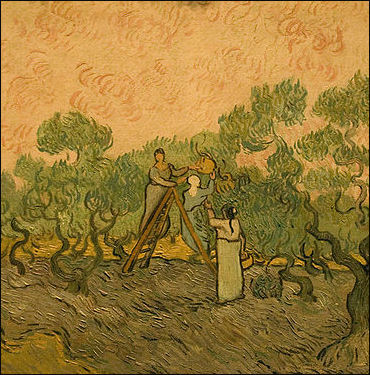
Women picking olives by van Gogh It is not uncommon for hazelnut oil, sunflower oil or vegetable oil to be illegally added to olive oil. In one case documented by Italian authorities a tanker ship loaded up with 2,200 tons of hazelnut oil in Turkey and after meandering journey via the North Sea arrived at the port Barletta in southern Italy with papers that said the oil was Greek olive oil. There it was loaded into tanker trucks and taken to a refinery operated by Italian olive-oil producer Riolo, where at least some of the hazel nut oil was blended with real olive oil, with mixture being sold as pure olive oil, much of it under brands owned by Nestle, Unilever, Bertolli and Oleifici Fasanesi. [Source: Tom Mueller, The New Yorker, August 13. 2007]
Producers of the adulterated olive not only make money from substituting cheaper oils for olive oil but also collect European Union subsidies intended to help the olive oil industry. Organized crime is believed to be involved in the scheme. One investigator told The New Yorker, “profits were compared to cocaine trafficking, with none of the risks.” [Ibid]
In 2005, a criminal ring that sold fake olive worth $8 million in several regions of Italy was broken up. It was accused of taking low-grade soy oil and canola oil and coloring it with chlorophyll and flavoring it with beta-carotene and packing it as extra-virgin olive oil. More sophisticated schemes use hazel nut oil and deodorized “lampante” olive oil, which are extremely difficult to detect by chemical analysis.
Olive oil fraud is something that has been going on since antiquity. Galen described oil merchants that mixed high quality olive oil with lard and other substances. Apicius provided a recipe for turning cheap Spanish oil into prized oil from Istria using minced herbs and roots. The Romans tried to prevent the fraud by requiring merchants to name the farm where the oil was pressed and record the exact weight of the oil they purchased. [Ibid]
World’s Top Olive Exporting Countries
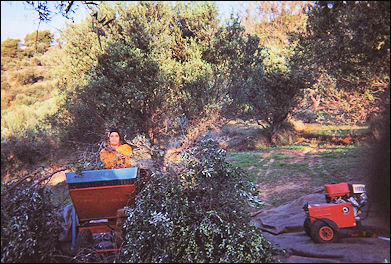
Olives Mechanical branch harvester
World’s Top Exporters of Olives (2020): 1) Portugal: 31124 tonnes; 2) Spain: 15376 tonnes; 3) Jordan: 7540 tonnes; 4) Greece: 5818 tonnes; 5) Philippines: 3405 tonnes; 6) Italy: 1126 tonnes; 7) Netherlands: 799 tonnes; 8) Germany: 494 tonnes; 9) United States: 325 tonnes; 10) Syria: 207 tonnes; 11) Turkey: 169 tonnes; 12) Belgium: 157 tonnes; 13) United Arab Emirates: 138 tonnes; 14) France: 99 tonnes; 15) Morocco: 99 tonnes; 16) Sri Lanka: 79 tonnes; 17) Austria: 69 tonnes; 18) Denmark: 60 tonnes; 19) Sweden: 58 tonnes; 20) Iran: 46 tonnes; 21) Lebanon: 46 tonnes ; [Source: FAOSTAT, Food and Agriculture Organization (U.N.), fao.org]
World’s Top Exporters (in value terms) of Olives (2020): 1) Portugal: US$21154,000; 2) Greece: US$12377,000; 3) Philippines: US$11844,000; 4) Spain: US$11565,000; 5) Netherlands: US$6301,000; 6) Jordan: US$6271,000; 7) Italy: US$4001,000; 8) Germany: US$1247,000; 9) France: US$934,000; 10) United States: US$808,000; 11) Belgium: US$585,000; 12) Sweden: US$498,000; 13) Denmark: US$273,000; 14) United Kingdom: US$234,000; 15) Sri Lanka: US$227,000; 16) Morocco: US$175,000; 17) United Arab Emirates: US$169,000; 18) Syria: US$121,000; 19) Turkey: US$114,000; 20) Austria: US$108,000
World’s Top Exporters of Preserved Olives (2020): 1) Spain: 497579 tonnes; 2) Greece: 216282 tonnes; 3) Morocco: 89500 tonnes; 4) Egypt: 77325 tonnes; 5) Peru: 77105 tonnes; 6) Turkey: 75994 tonnes; 7) Argentina: 51725 tonnes; 8) Italy: 29062 tonnes; 9) Portugal: 26865 tonnes; 10) Belgium: 19930 tonnes; 11) Albania: 10009 tonnes; 12) Syria: 9302 tonnes; 13) Germany: 8417 tonnes; 14) Netherlands: 7952 tonnes; 15) Russia: 6384 tonnes; 16) United States: 5789 tonnes; 17) Belarus: 5427 tonnes; 18) Czechia: 4570 tonnes; 19) United Arab Emirates: 4511 tonnes; 20) Bulgaria: 4123 tonnes
World’s Top Exporters (in value terms) of Preserved Olives (2020): 1) Spain: US$813646,000; 2) Greece: US$615319,000; 3) Morocco: US$141295,000; 4) Turkey: US$129307,000; 5) Peru: US$121693,000; 6) Egypt: US$97373,000; 7) Italy: US$88836,000; 8) Belgium: US$72291,000; 9) Argentina: US$66435,000; 10) Portugal: US$39738,000; 11) Germany: US$28583,000; 12) Albania: US$23740,000; 13) Netherlands: US$21302,000; 14) France: US$13374,000; 15) United States: US$12382,000; 16) Poland: US$9434,000; 17) Russia: US$7918,000; 18) Czechia: US$7033,000; 19) Bulgaria: US$6879,000; 20) Syria: US$6400,000
World’s Top Olive Importing Countries
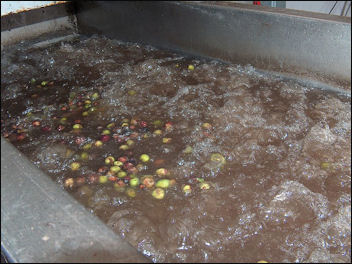
World’s Top Importers of Olives (2020): 1) Portugal: 35561 tonnes; 2) Spain: 5488 tonnes; 3) Italy: 5456 tonnes; 4) United States: 3912 tonnes; 5) Poland: 3505 tonnes; 6) Netherlands: 2047 tonnes; 7) France: 2014 tonnes; 8) Germany: 1271 tonnes; 9) Greece: 768 tonnes; 10) United Kingdom: 735 tonnes; 11) Romania: 714 tonnes; 12) Austria: 529 tonnes; 13) United Arab Emirates: 503 tonnes; 14) Ireland: 446 tonnes; 15) Belgium: 401 tonnes; 16) Bulgaria: 292 tonnes; 17) Saudi Arabia: 248 tonnes; 18) Canada: 238 tonnes; 19) Sweden: 217 tonnes; 20) Slovenia: 211 tonnes ; [Source: FAOSTAT, Food and Agriculture Organization (U.N.), fao.org]
World’s Top Importers (in value terms) of Olives (2020): 1) Portugal: US$18535,000; 2) Italy: US$9393,000; 3) Poland: US$6383,000; 4) Netherlands: US$6099,000; 5) France: US$4988,000; 6) United States: US$3990,000; 7) Israel: US$3625,000; 8) Germany: US$3512,000; 9) Spain: US$2290,000; 10) Ireland: US$1863,000; 11) Austria: US$1603,000; 12) Romania: US$1451,000; 13) Luxembourg: US$1235,000; 14) United Kingdom: US$1011,000; 15) Belgium: US$974,000; 16) Denmark: US$962,000; 17) Sweden: US$760,000; 18) Bulgaria: US$599,000; 19) Greece: US$584,000; 20) United Arab Emirates: US$563,000
World’s Top Olive Oil Producing and Exporting Countries
World’s Top Producers of Virgin Olive Oil (2019): 1) Spain: 1129233 tonnes; 2) Italy: 336581 tonnes; 3) Greece: 290476 tonnes; 4) Tunisia: 239500 tonnes; 5) Turkey: 217800 tonnes; 6) Morocco: 204200 tonnes; 7) Portugal: 154063 tonnes; 8) Syria: 153829 tonnes; 9) Algeria: 92200 tonnes; 10) Egypt: 41300 tonnes; 11) Palestine: 39610 tonnes; 12) Argentina: 30000 tonnes; 13) Lebanon: 26000 tonnes; 14) Jordan: 25500 tonnes; 15) Australia: 19700 tonnes; 16) Chile: 17000 tonnes; 17) United States: 16000 tonnes; 18) Israel: 15700 tonnes; 19) Albania: 11000 tonnes; 20) Libya: 8000 tonnes ; [Source: FAOSTAT, Food and Agriculture Organization (U.N.), fao.org]
World’s Top Exporters of Virgin Olive Oil (2020): 1) Spain: 1130319 tonnes; 2) Italy: 373328 tonnes; 3) Tunisia: 363616 tonnes; 4) Portugal: 201246 tonnes; 5) Greece: 174519 tonnes; 6) Syria: 63512 tonnes; 7) Turkey: 53665 tonnes; 8) Argentina: 22112 tonnes; 9) Chile: 16277 tonnes; 10) United States: 10612 tonnes; 11) Morocco: 10440 tonnes; 12) France: 9754 tonnes; 13) Lebanon: 6972 tonnes; 14) Germany: 6565 tonnes; 15) Palestine: 6456 tonnes; 16) United Arab Emirates: 5100 tonnes; 17) Netherlands: 4543 tonnes; 18) Belgium: 4430 tonnes; 19) Peru: 2903 tonnes; 20) Jordan: 2567 tonnes ; [Source: FAOSTAT, Food and Agriculture Organization (U.N.), fao.org]

Olive oil centrifuge World’s Top Exporters (in value terms) of Virgin Olive Oil (2020): 1) Spain: US$3230250,000; 2) Italy: US$1599199,000; 3) Tunisia: US$779858,000; 4) Portugal: US$645862,000; 5) Greece: US$561672,000; 6) Turkey: US$129237,000; 7) Syria: US$109275,000; 8) France: US$61090,000; 9) Argentina: US$59977,000; 10) Chile: US$57179,000; 11) Morocco: US$36647,000; 12) Germany: US$36484,000; 13) United States: US$34887,000; 14) Netherlands: US$24485,000; 15) Lebanon: US$23023,000; 16) Palestine: US$21802,000; 17) Belgium: US$20322,000; 18) United Arab Emirates: US$12992,000; 19) Austria: US$11783,000; 20) United Kingdom: US$10578,000
World’s Top Exporters of Olive Oil Residues (2020): 1) Spain: 100812 tonnes; 2) Greece: 40486 tonnes; 3) Italy: 37170 tonnes; 4) Tunisia: 15966 tonnes; 5) Portugal: 15428 tonnes; 6) Morocco: 9601 tonnes; 7) Turkey: 6703 tonnes; 8) United States: 6290 tonnes; 9) United Arab Emirates: 1584 tonnes; 10) Malaysia: 1550 tonnes; 11) Germany: 672 tonnes; 12) Lithuania: 464 tonnes; 13) Poland: 408 tonnes; 14) Latvia: 361 tonnes; 15) United Kingdom: 312 tonnes; 16) Australia: 295 tonnes; 17) Egypt: 266 tonnes; 18) Netherlands: 259 tonnes; 19) South Africa: 211 tonnes; 20) Belgium: 178 tonnes
World’s Top Exporters (in value terms) of Olive Oil Residues (2020): 1) Spain: US$170507,000; 2) Italy: US$59740,000; 3) Greece: US$36525,000; 4) Portugal: US$15316,000; 5) Turkey: US$11169,000; 6) Tunisia: US$9254,000; 7) Morocco: US$7382,000; 8) United Arab Emirates: US$5529,000; 9) United States: US$3990,000; 10) Netherlands: US$1705,000; 11) Germany: US$1533,000; 12) United Kingdom: US$1517,000; 13) Australia: US$1289,000; 14) Malaysia: US$1166,000; 15) Lithuania: US$1001,000; 16) Latvia: US$872,000; 17) Poland: US$777,000; 18) Croatia: US$360,000; 19) Czechia: US$345,000; 20) Russia: US$339,000
World’s Top Olive Oil Importing Countries
World’s Top Importers of Virgin Olive Oil (2020): 1) Italy: 608383 tonnes; 2) United States: 403619 tonnes; 3) Spain: 250246 tonnes; 4) Portugal: 144270 tonnes; 5) France: 142476 tonnes; 6) Brazil: 110395 tonnes; 7) United Kingdom: 82838 tonnes; 8) Germany: 81795 tonnes; 9) Japan: 67938 tonnes; 10) Canada: 61542 tonnes; 11) China: 49862 tonnes; 12) Turkey: 41942 tonnes; 13) Saudi Arabia: 38884 tonnes; 14) Australia: 38339 tonnes; 15) Russia: 28868 tonnes; 16) Belgium: 28097 tonnes; 17) United Arab Emirates: 22837 tonnes; 18) Netherlands: 21825 tonnes; 19) Mexico: 21595 tonnes; 20) South Korea: 20285 tonnes ; [Source: FAOSTAT, Food and Agriculture Organization (U.N.), fao.org]
World’s Top Importers (in value terms) of Virgin Olive Oil (2020): 1) Italy: US$1517014,000; 2) United States: US$1367122,000; 3) Spain: US$544332,000; 4) France: US$492063,000; 5) Brazil: US$429871,000; 6) Germany: US$359719,000; 7) Portugal: US$340560,000; 8) Japan: US$275568,000; 9) United Kingdom: US$247128,000; 10) Canada: US$206158,000; 11) China: US$156768,000; 12) Australia: US$135276,000; 13) Switzerland: US$108008,000; 14) Saudi Arabia: US$107510,000; 15) Netherlands: US$84894,000; 16) Russia: US$84295,000; 17) Belgium: US$83780,000; 18) South Korea: US$79139,000; 19) Mexico: US$75173,000; 20) Turkey: US$70819,000

Olive farm
Image Sources: Wikimedia Commons
Text Sources: National Geographic, New York Times, Washington Post, Los Angeles Times, Smithsonian magazine, Natural History magazine, Discover magazine, Times of London, The New Yorker, Time, Newsweek, Reuters, AP, AFP, Lonely Planet Guides, Compton’s Encyclopedia and various books and other publications.
Last updated June 2024
